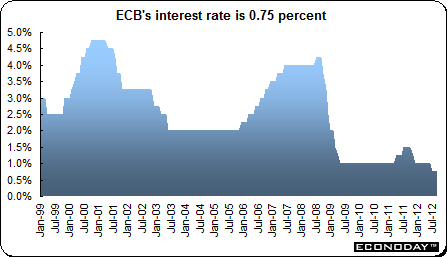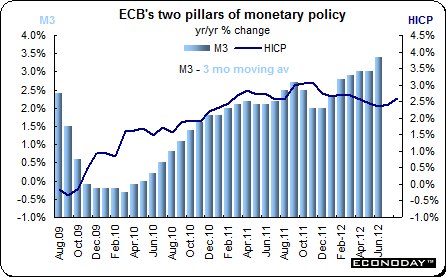The European Central Bank (ECB) continues to establish itself and its inflation fighting credentials. Founded by the European Union, the ECB is empowered to set monetary policy for the 17 countries which make up the European Monetary Union. In 2002, the ECB's biggest challenge was the conversion of the national currencies (i.e. the deutschmark, franc, lira, drachma etc) to the euro for all day to day transactions.
The ECB's governing council consists of 23 members representing the six members of the Executive Board and the governors of the national central banks of the 17 euro area countries. The council performs tasks similar to that of the Federal Reserve Open Market Committee (FOMC). They make decisions affecting the availability and cost of money and credit in member countries. Both make decisions about interest rate and money supply growth targets — although their approach differs in the decision making process. Critics are vocal in complaining about the ECB's lack of transparency. The ECB does not publish minutes of their meetings but does hold press conferences usually after the first meeting of the month to explain its actions. Decisions are made by consensus — no vote is taken.
The European Central Bank decides monetary policy and member national central banks implement it. Together these banks form the European System of Central Banks (ESCB). The president is Mario Draghi, a former governor of the Bank of Italy, who began an eight year term on November 1, 2011. The Bank was patterned after the German Bundesbank and follows many of its ways of doing business.

The ECB's prime objective is to maintain price stability through interest rate policies. The ECB makes decisions on interest rates by majority vote of its governing council as does the Federal Reserve. However, it differs in that it does not release a voting record. The council meets every other Thursday — just as the Bundesbank does — and more frequently than the FOMC but focuses on monetary policy only during the first meeting of the month except in crisis. The main monetary instrument is the repurchase rate (repo).
The ECB has adapted two policy guides —
- a monetary target of 4.5 percent growth of the M3 measure of money supply
- an inflation ceiling of 2 percent or less as measured by the harmonized index of consumer prices.

The ECB increased its key interest rate to 4.25 percent at its July 2008 meeting. Further rate increases were in the offing but did not occur because of August’s chaos in financial markets. The ECB is driven by a treaty-mandated inflation target of no higher than 2 percent. The ECB initially had been concerned about secondary effects of high energy prices. The Governing Council was also concerned that money supply growth was growing at over double their 4.5 percent reference target. The pace of money supply growth slowed dramatically and now only growing 1.7 percent on the year. The lack of growth in M3 is an indication of how weak bank lending has become. Inflation as measured by the harmonized index of consumer prices, after declining in mid-2009, gradually picked up. Prices have eased and the HICP now is up 2.4 percent on the year — more than the ECB’s 2 percent target. M3 money supply growth has been slower — it is now up 2.8 percent on the year.
Despite plummeting growth, the ECB was intent upon continuing its inflation fight and did not join the Federal Reserve, Banks of Canada and England in lowering interest rates during the summer of 2008. The ECB continued to hold fast until the coordinated interest rate reduction on October 8, 2008 when it joined the Fed, Banks of Canada and England and others and cut rates by 50 basis points to 3.75 percent. The ECB continued to cut rates in a measured fashion. Its last cut took its key rate to 1 percent in May 2009. Because of its focus on inflation, the ECB increased interest rates twice — in April and July 2011. Even with the stresses of the sovereign debt crisis the ECB held fast to its mandate — but did make loans more accessible to banks.
One of the first moves by the new ECB president was to lower interest rates which he did at both the November and December 2011 meetings. He has also increased liquidity by making loans available to banks at low rates for an extended time period. The ECB lowered its key refinance rate to 0.75 percent at its July meeting after the EU agreed to a series of moves to help Spain.
At its much awaited September meeting, Mr Draghi announced a bond buying program to help beleaguered Spain and Italy. However, the caveat is that any outright monetary transactions (OMTs) will be subject to the conditions laid down by the relevant EFSF/ESM adjustment program, ideally with input from the IMF. Moreover, any addition to liquidity will be sterilized. This means that the use of OMTs will not constitute quantitative easing which may not impress some.
|